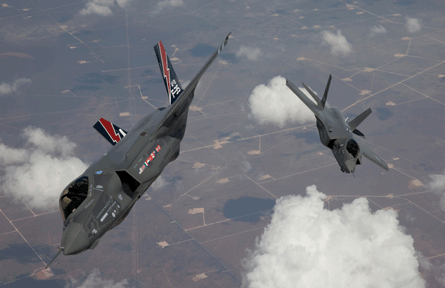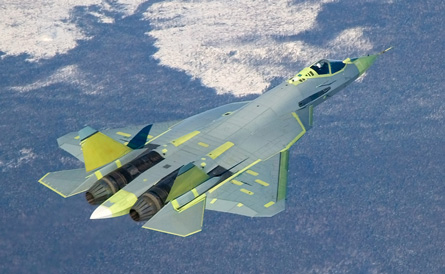The future is not as dark as it may seem for the world's largest military aviation power - the USA. In the next 12 months, Lockheed Martin's short take-off and vertical landing F-35B variant for the US Marine Corps is unlikely to be cancelled, procurement spending will probably increase slightly in fiscal year 2011, and overall capabilities in military aviation will continue to expand.
But the need for such assurances at the end of 2010 speaks volumes about the economic climate after a more than a decade of steadily rising defence budgets. In November, President Barack Obama's fiscal commission wrapped defence cuts into a plan to reverse runaway government spending projected to generate a $1.2 trillion deficit in 2010 alone.
 |
|---|
© US Air ForceDespite military cuts, the F-35B for the US Marine Corps is unlikely to be cancelled |
Tucked inside the commission's non-binding package of proposals included scrapping the F-35B and Bell Boeing MV-22 Osprey tiltrotor, capping the F-35A and F-35C for the US Air Force and US Navy, respectively, and slashing overall procurement spending by 15%.
Any one of these proposals, if adopted, would reverberate across the global aerospace sector, but all of them together would jolt US industry more than any change since its post-1993 consolidation.
The Obama administration has not signalled that such fundamental changes are imminent, but industry officials have clearly taken note. Since August, Lockheed and Boeing, notably, have slashed executive payrolls, started discarding newly unwanted systems integration capabilities and consolidated industrial operations. The industry will continue reshaping itself throughout 2011, and as fiscal pressures and operational requirements combine, large-scale systems integrations managed by contractors will evaporate.
Fittingly, the US Army cancelled the Boeing Future Combat System (FCS) programme in early 2010, but at the end of the year awarded the company the enhanced medium altitude reconnaissance and surveillance system (EMARSS).
If FCS typified the systems integration approach of the previous decade, EMARSS may be the model for the decade ahead. Descended from the failure of the Aerial Common Sensor programme, its goals are relatively simple. Boeing must integrate an existing communications and signals intelligence system on an existing airframe - the unglamorous Beechcraft King Air 350ER. In addition, EMARSS is not aimed at addressing an indeterminate future threat, but an urgent, critical need for intelligence in Afghanistan and other current operations.
Big-ticket aviation programmes will not disappear from the landscape, but they are becoming harder to sustain at planned production rates. The F-35 programme - the largest single project in global aerospace history - is still struggling to overcome an accumulation of software and manufacturing shortfalls under the ongoing technical baseline review process.
The US military's acquisition system itself will face more scrutiny than ever. The air force's botched handling of proprietary bid information in the KC-X tanker competition - a final decision on which should come early in the year - raises memories of serial contracting failures over the past decade. As the same service launches a competition to replace its Sikorsky HH-60 and Bell UH-1 helicopter fleets, industry officials already seem to be preparing to protest about perceived flaws in the acquisition process.
The global combat aircraft sector will continue to grab many headlines, despite its failure to achieve expected contract signatures in 2010. Will this be the year when Brazil finally decides its long-delayed fighter selection, or will its change of leadership prompt another new start, frustrating rivals Boeing, Dassault and Saab?
In Asia, India may narrow the field in its huge medium multi-role combat aircraft battle after February's high-profile air show near Bangalore, but expectations of a type selection in the next 12 months may be disappointed again. But, as evidenced by New Delhi's planned collaboration with Moscow on a joint development of the latter's PAK-FA demonstrator, the nation's air force is on the road to becoming even more of a global power.
 |
|---|
© Sukhoi |
This will also be demonstrated in February with the arrival of the first of its six Lockheed C-130Js, and India could also sign a massive order for 10 Boeing C-17 strategic transports and advance its planned acquisition of a new tanker/transport design.
Elsewhere in the region, South Korea could advance ambitious plans for an indigenous fighter development, possibly after attracting financial and industrial backing from Indonesia and Turkey. And Japan will begin the search to replace some of its McDonnell Douglas F-4 Phantoms, after finally abandoning hope of acquiring Lockheed's F-22 Raptor.
This year will also provide more clarity on the level of spending cuts facing some of Europe's armed services. The UK has already felt the pain - such as last month's sacrifice of its BAE Systems Harrier GR9/9A force - but the detail for others, such as Italy, has yet to emerge.
The coming months will also show how a planned increase in military co-operation between France and the UK will take shape in practical terms, and perhaps reveal the possible direction of some of their more ambitious long-term joint projects, such as for unmanned combat air vehicles.
With companies on both sides of the Channel keen to take the lead on such an initiative, it will be interesting to see whether all parties can be satisfied.
Additional reporting by Craig Hoyle
Source: Flight International
















